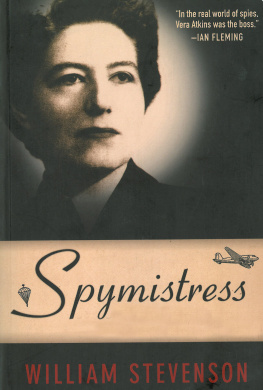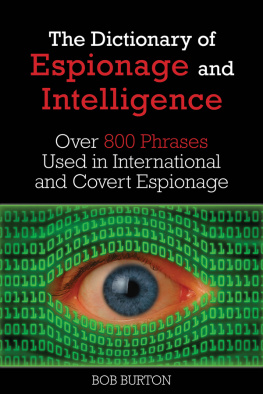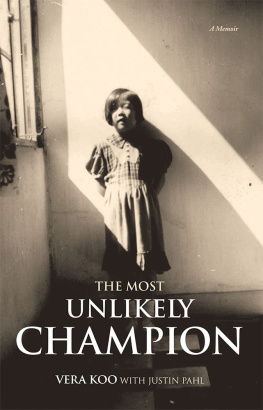

S pymistress


S pymistress
The True Story of the Greatest
Female Secret Agent of World War II
WILLIAM STEVENSON

Copyright 2007, 2011 by William Stevenson
All Rights Reserved. No part of this book may be reproduced in any manner without the express written consent of the publisher, except in the case of brief excerpts in critical reviews or articles. All inquiries should be addressed to Arcade Publishing, 307 West 36th Street, 11th Floor, New York, NY 10018.
Arcade Publishing books may be purchased in bulk at special discounts for sales promotion, corporate gifts, fund-raising, or educational purposes. Special editions can also be created to specifications. For details, contact the Special Sales Department, Arcade Publishing, 307 West 36th Street, 11th Floor, New York, NY 10018 or arcade@skyhorsepublishing.com .
Arcade Publishing is a registered trademark of Skyhorse Publishing, Inc., a Delaware corporation.
Visit our website at www.arcadepub.com .
10 9 8 7 6 5 4 3 2 1
Library of Congress Cataloging-in-Publication Data is available on file.
ISBN: 978-1-61145-231-0
Printed in the United States of America
Contents
Preface
V era Atkins was the brilliant, highly effective leader of a select group who fought in secrecy against the Nazis in occupied Europe after the fall of France in 1940. These brave young men and women had volunteered for Special Operations Executive (SOE), improvised at this time of greatest peril by Winston Churchill, the last hope of a country whose leaders he had tried for years to awaken to the growing danger of Nazi Germany. Long out of office, he suddenlyalmost too late, he remarkedbecame prime minister on May 10, 1940, at which point he had to confront those in Whitehall who sought to appease Hitler and make a separate peace. Even loyal staff officers in the War Office of Churchill's government resented the secrecy surrounding SOE and feared that its agents violent actions against the enemy were incompatible with democratic traditions, offending international law and the concept of habeas corpus. To these niceties, the utterly pragmatic Churchill responded by instructing the British chiefs of staff to develop a reign of terror to make the lives of German occupiers an eternal torment. That message also gave Vera Atkins's SOE a license to conduct her campaign in occupied France as her extraordinary mind and steely resolve dictated.
Churchill's hope after he became prime minister was that, sooner or later, America would join England in opposing the formidable Nazi war machine, for despite his indomitable public figure and ringing statements, he was far from sure England could win alone. His relations with President Roosevelt were good, but as the 1940 election neared, Roosevelt warned his friend that antiwar sentiment in the States was high, even overwhelming, which he could not ignore. In that election year Rooseveltand the American peoplewere also far from convinced England would win the war. To get a better picture, FDR sent his trusted confidant William J. Donovan, the future head of OSS, to London to assess the situation. There Donovan was put in contact with Vera Atkins. She so impressed him that he reported back to the president his strong impression of her, and Britain's, courage and his conviction that the tide would be turned. Thus it is fair to say that, in addition to her accomplishments as Britain's Spymistress, she was also a key factor in convincing the Roosevelt administration of the Allies ultimate success.
SOE was Churchill's desperate attempt to demonstrate that there was life in the old lion yet and, indeed, to make life an eternal torment for the Nazis, who after their blitzkrieg attacks across continental Europe were preparing to carry out Hitler's Directive 16 and invade England. SOE's mandate from the start was to sabotage, burn, harass, and kill the enemy, to set the continent ablaze. Its numbers were strikingly few. Of 480 agents in the French Section, 130 were tortured, and many were executed in shocking circumstances. Despite their heavy losses, these men and women, over the four long years of German occupation, wreaked havoc on the Nazis throughout the country. With the growing help of the French Resistance, they cut phone lines to force the Germans to communicate by wireless (so Bletchley could intercept), blew up bridges and tunnels, and derailed military trains. As this book shows, at the time of the Normandy invasion on June 6, 1944, they were so effective in harassing the German divisions rushing from the south of France and the Eastern Front to reinforce Normandy that they slowed down their arrival long enough, perhaps, to have turned the tide of the war.
In prewar Europe, Vera had already been working against this ruthless enemy. She was aided in this clandestine effort by William Stephenson (Intrepid), a Canadian businessman who, together with some other imported North Americans, had early sensed the dangers inherent in Hitler's rise to power, and formed in New York the British Security Coordination (BSC) office. Meeting Vera first in Bucharest and later in London, Stephenson was so impressed by her mind, her mastery of several languages, her dedication, and her fierce anti-Nazi stance that he sent her on fact-finding missions to several European countries, secretly reporting her findings to a few trusted souls in Britain. Together they supplied Churchill, then in his political wilderness, with facts about the growing Nazi threat and the sorry neglect of UK defenses. These facts were ignored by most members of Parliament before the outbreak of World War II on September 1, 1939, when the first German blitz quickly subjugated Poland. A fierce Polish anti-Nazi resistance arose from the ashes to inspire similar resistance movements in other German-occupied countries. Vera immediately saw that France, just across the English Channel, would soon be fertile ground for her agents.
Despite her very British name and demeanor, Vera was actually Romanian Jewish, born Vera Maria Rosenberg in Bucharest. In England, this put her at constant risk from the Alien Act of 1793 and the Official Secrets Act, which criminalizes the publicationeven the republicationof certain kinds of information deemed to be a security risk. She took the name Vera Atkins, derived from her mother's maiden name, Etkin, to avoid detention as an enemy alien. Into her old age, she would dance and make merry with SOE survivors who knew her only as Miss Atkins, who honored her for superior qualities of intellect and loyalty, and who never talked of their wartime work until SOE came under attack by postwar critics.
Colonel Maurice Buckmaster, who had worked alongside Vera, was thunderstruck when in October 1958 a book entitled Double Webs was published. Its author, Jean Overton Fuller, claimed that SOE's air movements officer in France, Henri Dericourt, had actually been a double agent and that SOE agents were deliberately sacrificed to draw the Gestapo away from still more secret operations. On November 13, 1958, Dame Irene Ward, a member of Parliament, proposed to table a motion calling for an Official Secrecy Act Inquiry into these and other allegations of SOE incompetence. She was persuaded not to proceed by then prime minister Harold Macmillan, who said an official history would be commissioned. This appeared eight years later, in 1966, written by M. R. D. Foot, with details approved by the government and published by Her Majesty's Stationery Office.
Next page


















